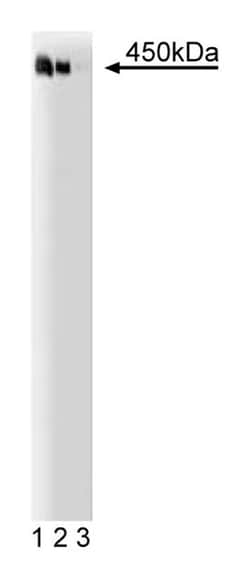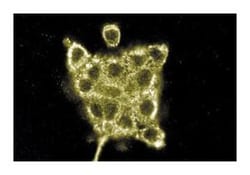Learn More
AKAP450 Mouse anti-Human, Unlabeled, Clone: 7, BD
Mouse Monoclonal Antibody
Supplier: BD Biosciences 611518
Description
Compartmentalization of the type II cAMP-dependent protein kinase (PKA) within the cell is essential for its discrete physiological effects. PKA localization is mediated by interactions between the regulatory (RII) subunit and A-kinase anchoring proteins (AKAPs) which position PKA in close proximity to relevant substrates. Some AKAPs exhibit tissue specific expression, while others are detected ubiquitously. AKAP450 localizes PKA type II to centrosomes. The N-terminal portion of AKAP450 (amino acids 1-1626) is almost identical to the Yotiao protein (∽210 kDa), an AKAP that localizes PKA to NMDA receptors. In addition, AKAP450 contains three major regions (cc1, cc2, cc3) of coiled coil structures, which are characteristic features of centrosomeal proteins. It is expressed at low levels in multiple tissues, including skeletal muscle and liver, but is highly expressed in kidney. PKA is thought to be involved in the maintenance of the interphase microtubule network and to be necessary for stabilization of minus-end microtubules that originate from the centrosome. Thus AKAP450 may serve as a scaffolding protein to localize PKA and other signaling molecules together in cetrosomes.
This antibody is routinely tested by western blot analysis. Other applications were tested at BD Biosciences Pharmingen during antibody development only or reported in the literature.

Specifications
| AKAP450 | |
| Monoclonal | |
| 250μg/mL | |
| Aqueous buffered solution containing BSA, glycerol, and ≤0.09% sodium azide. | |
| Human AKAP450 aa. 17-130 | |
| 50 μg | |
| Cell Biology | |
| Human | |
| IgG1 |
| Western Blot | |
| 7 | |
| Unconjugated | |
| Mouse | |
| Affinity Purified | |
| RUO | |
| Primary | |
| Store undiluted at -20°C. |
Your input is important to us. Please complete this form to provide feedback related to the content on this product.

